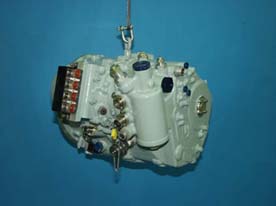Kawasaki and Shinko Electric Develop New Aerospace Traction Drive T-IDG®
Nov. 14, 2006

|
Tokyo, November 14, 2006 — Kawasaki Heavy Industries, Ltd. announced today that Kawasaki and Shinko Electric Co., Ltd. have jointly developed the T-IDG, the world’s first traction drive integrated drive generator (IDG) employing a TD-CVT*1 for application in large-size aircraft. An IDG is the main power supply unit used in aircraft jet engine. It consists of an AC power generator combined with a constant-speed drive unit to drive the generator at a constant revolution speed. This constant-speed drive unit makes it possible to maintain a stable and constant frequency power supply for an aircraft regardless of engine revolutions. The newly developed T-IDG is the world’s first IDG for aircraft applications employing a high-speed TD-CVT, instead of the conventional hydraulic CVT, as the constant-speed drive unit. It delivers significantly enhanced efficiency and durability compared with other existing models while ensuring superior power supply quality due to its high controllability as well as increased aircraft fuel economy and reliability. In developing the T-IDG, Kawasaki worked on the overall integration of the TD-CVT and IDG while Shinko Electric was responsible for the generator and its control unit. The T-IDG uses a half-toroidal TD-CVT that allows for an infinite variability in the speed ratio by changing the angle of the rollers located between the two half-toroidal-shaped discs that face each other. The technological breakthroughs Kawasaki achieved in developing its TD-CVT for practical aerospace applications include: 1) Reduced weight 2) Higher efficiency and reliability 3) Environment resistance 4) High response The new T-IDG is capable of controlling the variable engine speed (approximately 5,000 to 10,000 rpm) with the TD-CVT to maintain a constant traction drive speed and ensure a stable supply of AC power to an aircraft at a constant frequency of 400 Hz. The T-IDG can supply up to 90 kVA of power and will be upgraded to 250 kVA in the future. Kawasaki plans to develop a line of products that will expand aerospace applications of the T-IDG on a global basis. *1.TD-CVT: traction drive continuously variable transmission. A traction drive is a power transmission mechanism that utilizes the viscous resistance of oil film and can transmit power between two objects with a smooth surface. Tilting the roller placed between two half-troidal-shaped discs can adjust the input/output speed ratio with no discrete steps or shifts. This type of CVT is called a half-troidal CVT. |





